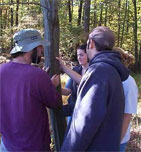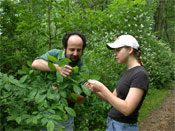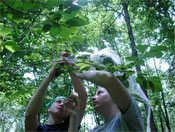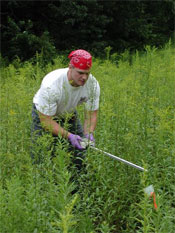Research - Graver Arboretum
Examples of Muhlenberg field study at Graver Arboretum:
ESC 113 Fall 2005 (Laurie Rosenberg)
Biodiversity of Phytoplankton in a Sunny vs. Shady Pond - Annie Davis
BIO 260 Field Botany and Plant Ecology (Dr. Richard Niesenbaum)

BIO 270 Ecology (Dr. Erika Iyengar)
- Goldenrod gall distribution sampling lab, determining random, even, or clumped distribution.
- Independent project looking at whether galls were more common on edges or in the center, and whether they were larger in either of those areas.
- Spring bird feeding behavior observation.
- Sampling a small shaded pond vs a larger, sun-exposed pond for planktonic organisms.
BIO 281 Aquatic Ecology (Dr. Erika Iyengar)
- Pond organism sampling, both plankton and the bottom dwelling macroinvertebrates and fish.
Examples of student independent research at Graver
With funding from the National Science Foundation, Dr. Richard Niesenbaum has initiated a major research program on plant-herbivore interactions in relation to human disturbance. The research is being conducted in established research plots at the Graver Arboretum and at the Raker Preserve. With support from the National Science Foundation, Merck/AAAS, and Muhlenberg College, seven students were involved in this project and they developed related research projects at the two sites. Rich Niesenbaum and three students presented their research at the Botany 2002 Conference in Madison, WI. Students describe their projects below.
- Emily Kluger
I am studying the relationship between light intensity, leaf age, and herbivory rates in Lindera benzoin (Spicebush). Feeding trials in both the field and laboratory, leaf toughness tests, and measurements of new growth rates in sun and shade Spicebush were used as the primary indicators of variance in plant defense against herbivore attacks relative to light environment and leaf age. The results of this study will answer ecological questions regarding a plant's susceptibility to herbivore damage in the presence of an increased resource (light) and account for age-based differences in leaf resiliency to defoliation. - Lauren Mastro
In my study, I am examining whether or not touching spice bush (Lindera benzoin) affects the parasitism rate in the geometrid (Melanolophia canadaria) feeding on the plants. My objectives are: 1. To determine if touched plants have greater/smaller rate of caterpillar parasitism than non-touched plants 2. To determine if touched plants have more/less caterpillars feeding on them than non-touch plants and 3. To determine if shade or sun plants have more caterpillars. The study will be conducted using 120 plants, half of which will be touched once a week. Caterpillars will be collected on a daily basis and raised in environmentally simulated conditions to determine rate and type of parasitism. - Stephanie Zettel
I am studying presence ecology in relation to walking paths. I am measuring the change in the physical environment including Par light (uM/m^2s), soil moisture, soil temperature, soil compaction, root biomass, external temperature and relative humidity. I am also measuring insect diversity and abundance. I am also studying trichome production in new leaves and stems of Solidago juncea versus old leaves and stems after various treatments are applied. - Jeff Dipple
I am studying the effects of neighbor removal, touch, and visitation on growth and herbivory in dogbane and goldenrod. - Rich Kipp
I am doing analyses of plant chemistry with respect to herbivore defense, light environment, touch, and visitation.
|
|
|
|
|
|
|
|
|






